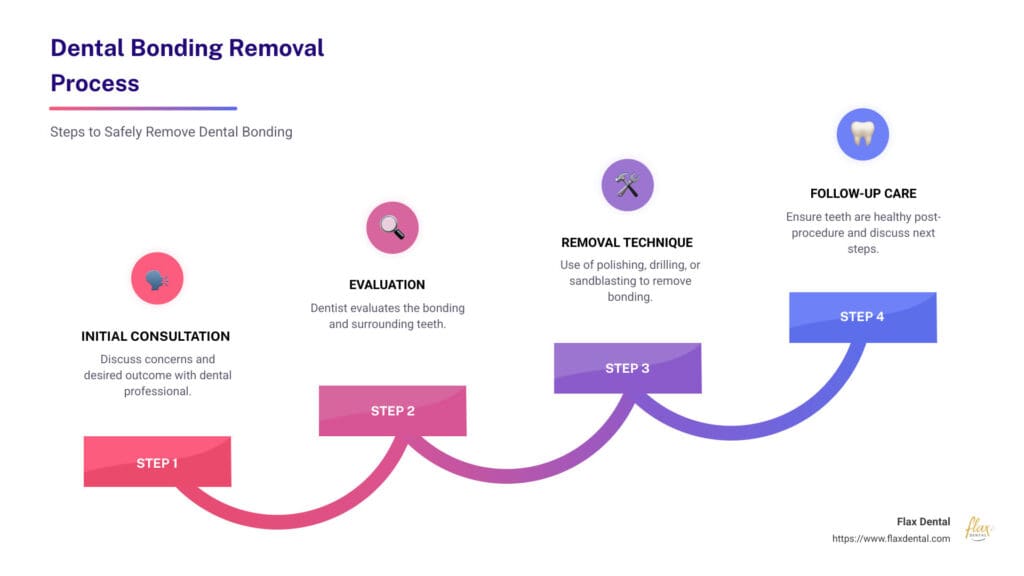Dental bonding is a popular way to fix small issues like chips or gaps in your teeth. It uses a special resin that matches your tooth color, which a dentist shapes and hardens. But if you’re not happy with the results or want to try something else, the good news is that a dentist can safely remove bonding.
Options like sandpaper disks, carbide drills, or micro-etchers can remove the bonding without harming your teeth. Just make sure to see an expert to avoid damaging your enamel.
I’m Dr. Hugh Flax, and I’ve been working in advanced cosmetic dentistry for decades. I know how to remove dental bonding safely, so you can upgrade your smile with a more permanent option. Let’s dive into this topic together and learn more.

Can Dental Bonding Be Removed?
Safe Removal Methods
Removing dental bonding is a precise process. It’s all about preserving your teeth while getting rid of the composite resin. Here are the safe techniques that your dentist can use:
- Sandpaper Disks: These flexible disks help polish and gradually remove the bonding material. They bend to your tooth’s shape, ensuring a smooth finish. They’re great for a gentle approach but can take time. They’re especially useful for smaller areas or when you want to avoid aggressive techniques.
- Carbide Drills: These high-speed tools remove bonding material faster. However, they can leave streaks behind, so dentists often follow up with sandpaper disks for a polished look. They’re ideal for larger areas or when time is a factor.
- Micro-Etcher: Think of this as a finishing touch. It’s a slow process but perfect for ensuring all remnants of bonding are gone. It’s gentle on your enamel and works well for fine-tuning the final result.
Each method has its pros and cons. The key is to work with an experienced dentist who can choose the best method for your situation. They’ll make sure your teeth stay healthy while giving you the smile you want.
Potential Risks and Considerations
While dental bonding removal is generally safe, there are some risks to keep in mind.
- Enamel Damage: If not done carefully, there’s a risk of sanding away some of your tooth’s natural enamel. This is why it’s crucial to have a skilled dentist handle the procedure. They’ll use precise techniques to protect your enamel and keep your teeth healthy.
- Tooth Sensitivity: You might experience sensitivity after the bonding is removed. This is because the enamel, which protects your teeth, could be slightly affected during the process. The sensitivity is usually temporary and can be managed with desensitizing toothpaste or treatments recommended by your dentist.
- Discoloration: Once the bonding is gone, your teeth might not look exactly as they did before. The etching process used during bonding can make the enamel look different once the resin is removed. In some cases, your dentist might recommend whitening or other cosmetic treatments to even out your smile.
Knowing these risks helps you make an informed decision. Consulting with a professional like Dr. Hugh Flax can ensure the process goes smoothly, minimizing any potential issues. He’ll guide you through the process and help you achieve the results you want while keeping your teeth safe and healthy.
Why Remove Dental Bonding?
Dental bonding is a great solution for many, but it might not be the best fit for everyone. The composite resin used in bonding can discolor and cause a mismatch with your teeth over time. This discoloration isn’t just a cosmetic issue. It can also affect your confidence and how you feel about your smile. If the bonding starts to chip or wear down, it might leave you feeling uncomfortable or dissatisfied.
Transitioning to Other Treatments
You have options if you’re unhappy with your dental bonding or want a more durable and long-lasting solution. Two of the most common choices are veneers and crowns. Both have their own advantages, depending on what your teeth need and what you want to achieve.
Porcelain veneers are a great option if you want a more natural and even look for your smile. They are thin, custom-made porcelain shells that cover the front of your teeth. Veneers are strong, resist stains, and can make your smile look better.
Unlike dental bonding, which can sometimes look less natural over time, veneers consistently have a smooth and polished look. They work well for fixing problems like stains, small chips, or gaps between teeth. Plus, veneers don’t need much preparation, so more of your natural tooth is left intact.
On the other hand, dental crowns are better for patients who need both cosmetic and structural improvements. A crown covers the whole tooth to restore its shape, size, and strength. This makes crowns a good choice for badly damaged, decayed, or weak teeth. Unlike bonding, which only covers the surface, crowns provide full support to the tooth, making it stronger and more functional.
Both veneers and crowns can improve your smile in different ways. They don’t just fix how your teeth look, they also help with function. Veneers are usually picked for their flawless look, while crowns are chosen for their strength and ability to fix damaged teeth.
Schedule A Visit
If you’re thinking about switching from dental bonding, it’s important to talk to an experienced dentist. A professional like Dr. Hugh Flax can check your dental health, talk about your goals, and help you decide if veneers, crowns, or another treatment is the best choice for you. By exploring these options, you can get a smile that looks great and lasts a long time.
Your smile is a personal statement, so we’re here to help you make it the best it can be. Whether you’re considering removing dental bonding or exploring other cosmetic options, visit Flax Dental in Atlanta, GA. Our focus is on providing expert consultation and personalized care.
If you’re ready to explore your options or have more questions about removing your dental bonding, call 470-635-3604 or request an appointment online.
